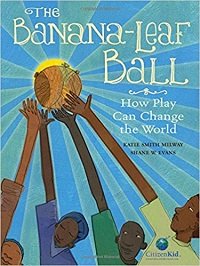| ________________
CM . . .
. Volume XXIII Number 30. . . .April 14, 2017
excerpt:
Part of the “CitizenKid” series, The Banana-Leaf Ball, set in a refugee camp in Lukole, Tanzania, is based on the true story of Benjamin Nzobonankira. In 1993, at the age of 10, Benjamin and his family had to flee their home in Burundi when war broke out. He became separated from his family, travelling for months through the forest and surviving on plants and rainwater. Eventually, he was reunited with his father and some cousins at the refugee camp in Lukole. Life in the camp, with limited resources and a problem with gangs, was not easy, but the 2001 arrival of a coach from Right to Play marked the beginning of the creation of a peaceful community through sport and play. The emphasis on teamwork, education and the peaceful resolution of conflict helped to change attitudes and to empower children to overcome the effects of poverty, disease and conflict. Benjamin became a Right to Play volunteer, and eventually, when the camp closed, he returned to his native Burundi where, as leader of the national training team, he trained hundreds of coaches. The book tells the story of Deo, a young boy whose character is based on Benjamin’s. Upon arriving at the refugee camp after several weeks of travelling, Deo attends school but keeps to himself. He misses the soccer games he used to play with his old friends, and he begins to fashion some dried banana-leaf twine with which to make a soccer ball. But Remy and his gang of bullies attack Deo and steal the twine. Deo creates another ball, hiding it this time. One day, a man with a real soccer ball appears at the camp and invites the children to form teams and play a soccer game. He appoints Deo as one of the team captains and, fortunately, places Remy on the same team. Skill and teamwork result in a win for their side, and so begins a tentative friendship between the boys. The next day, Deo shows the other children how to make a banana-leaf ball so that they can have fun playing soccer. Little by little, life in the refugee camp improves, and instead of living in fear, the people have hope for the future. At the back of the book, readers will find Benjamin’s true story as well as a map of East Africa and a couple of photos, one of banana-leaf balls and another of Benjamin with the children in the camp. There are a few pages devoted to six organizations from various parts of the world which foster compassion and confidence in boys and girls through sport and play. Also included are the rules for some fun games to try. Deo’s story is told very simply, and though it might appeal to the older readers in the publisher’s target audience (ages 8-12), the text’s short sentences and the author’s writing style lend themselves to a younger audience. Illustrations, mostly rendered in greens, blues, golds and oranges and browns capture the East African setting and suit the mood of the book. Though The Banana-Leaf Ball is worthy of purchase, this particular title is not quite as appealing visually or in terms of its content as are some of the others in the “CitizenKid” collection. Recommended. Gail Hamilton is a former teacher-librarian in Winnipeg, Manitoba.
To comment
on this title or this review, send mail to cm@umanitoba.ca.
Copyright © the Manitoba Library Association. Reproduction for personal
use is permitted only if this copyright notice is maintained. Any
other reproduction is prohibited without permission.
Next Review | Table of Contents For This Issue - April 14, 2017 |
